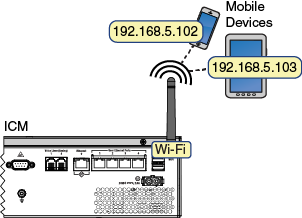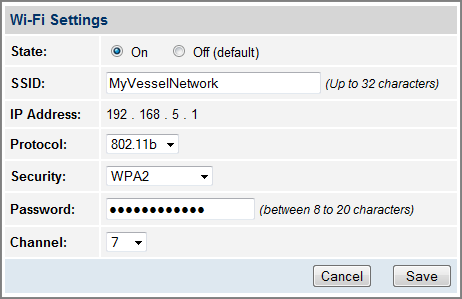
With Wi-Fi enabled, vessel devices can connect to the ICM via its built-in wireless access point (WAP) and receive IP addresses from the ICM via DHCP.
Important! |
The range of the ICM’s WAP will depend on the layout and structure of the vessel. For example, wireless signals degrade when passing through bulkheads and near metal masses. If the system is installed on a steel vessel, you might need a special WAP and the services of a technician with advanced networking expertise. |
Wireless DHCP (Example)

NOTE: If the optional CommBox software is enabled, or the ICM is configured for Dual Dome-Secondary or Legacy mode, the Network Settings page of the ICM/myKVH will not contain any configurable fields.
To enable and configure the ICM’s Wi-Fi connection, follow these steps:
At the TracPhone V11-IP web interface, click the Settings tab. Then click Network Settings.
NOTE: You can also change the ICM’s Wi-Fi settings at the myKVH web portal (www.mykvh.com). Go to the ICM > Network Configuration section of the Vessel Details page and select Wi-Fi Settings.
In Wireless Settings, click Edit.
If the Login window appears, log in with the Administrator password.
Set the following wireless options:
State: Select On.
SSID: Enter a unique name for the vessel network.
Protocol: Select either 802.11b or 802.11g.
Security: Select either security type – WPA2 or WEP (128-bit).
Password/Passphrase: If you selected WPA2, enter a password (between 8-20 characters). If you selected WEP, enter a passphrase (must be 13 characters).
Channel: Keep the default, or select any channel for wireless communications.
Important! |
Failure to apply security settings will make your vessel’s wireless network vulnerable to outside intrusion. |
Wireless Settings

Click Save.
At the confirmation message, click Save.
Make sure your computers are equipped with a wireless network interface card and configured for DHCP addressing (see Configuring Computers for DHCP).